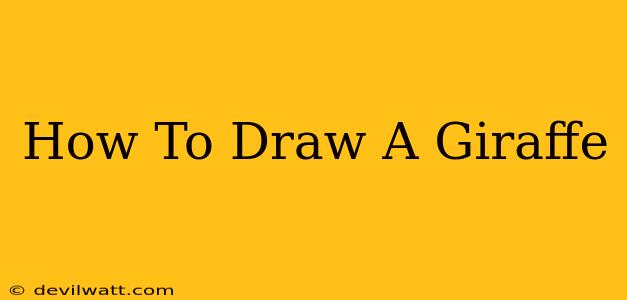So you want to learn how to draw a giraffe? These majestic creatures, with their long necks and spotted coats, are a fun and rewarding subject for artists of all skill levels. This guide will walk you through a simple, step-by-step process, perfect for beginners, while also offering tips for more advanced techniques to add realism and personality to your giraffe drawings.
Getting Started: Materials You'll Need
Before we begin our artistic journey, let's gather our supplies. You won't need anything fancy! Here's what you'll need:
- Paper: Any drawing paper will do, but thicker paper is preferable to prevent smudging.
- Pencil: A regular HB pencil is a great starting point. You can also use a 2B or 4B for darker lines and shading later on.
- Eraser: A good quality eraser is essential for correcting mistakes.
- Sharpener: Keep your pencil sharp for precise lines.
- Optional: Colored pencils, markers, or paints to add color to your finished giraffe drawing.
Step-by-Step Guide to Drawing a Giraffe
Let's start drawing! Follow these steps to create your own giraffe masterpiece:
Step 1: The Basic Shape
Begin by sketching a simple, elongated oval. This will form the body of your giraffe. Don't worry about making it perfect; it's just a guide.
Step 2: The Neck and Head
Draw a long, slightly curved line extending upwards from the top of the oval. This is the giraffe's neck. At the end of the neck, add a small circle for the head.
Step 3: Legs and Hooves
From the bottom of the oval, draw four long, slender legs. Each leg should end in a small, oval-shaped hoof. Remember that giraffes have long, elegant legs!
Step 4: The Giraffe's Head Details
Add details to the head: two large, expressive eyes, small ears on either side of the head, and a small, simple mouth.
Step 5: The Spots!
This is where your giraffe really comes to life! Add irregular, oval-shaped spots all over the body and legs. Don't make them perfect; natural spots are uneven and varied in size.
Step 6: Refining Your Giraffe
Once you're happy with the placement of your spots, carefully refine your lines, erasing any unnecessary guidelines. Add more details if desired, such as a slightly curved backline, a longer tail, or more defined musculature.
Advanced Techniques for a More Realistic Giraffe
Once you've mastered the basics, here are a few tips to elevate your giraffe drawing to the next level:
- Shading: Use shading to add depth and dimension to your giraffe. Pay attention to the light source and shade accordingly, adding darker tones to create shadows and highlighting areas where the light hits.
- Texture: Experiment with different pencil techniques to create texture in the giraffe's fur and skin. Light strokes can suggest soft fur, while heavier strokes can create a more textured feel.
- Perspective: Consider the perspective from which you are drawing your giraffe. This can significantly impact the look and feel of your final drawing.
Practice Makes Perfect
Drawing takes practice, and it's okay to make mistakes! Don't be discouraged if your first attempt isn't perfect. The more you practice, the better you'll become. Try drawing giraffes in different poses, and experiment with different styles. The key is to have fun and express your creativity!

